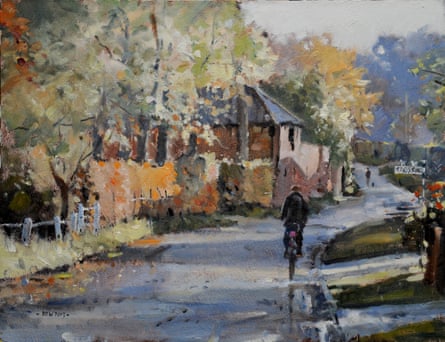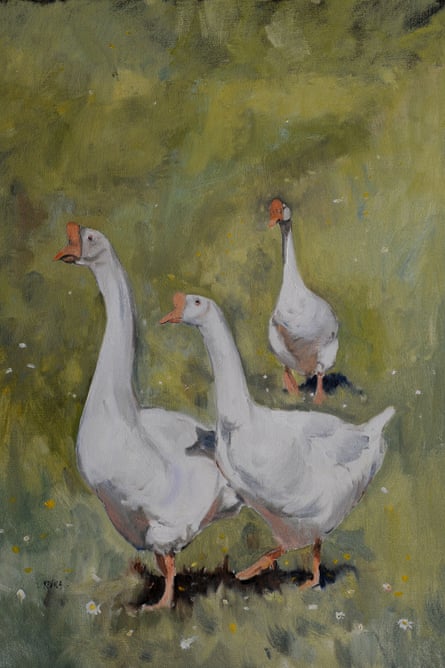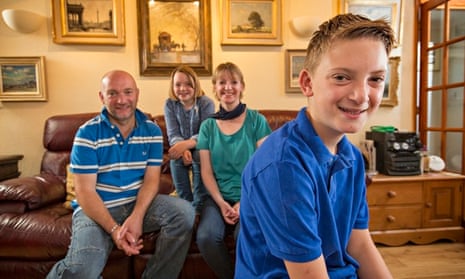The artist Kieron Williamson is standing in a busy gallery, explaining Ducks Crossing, a beautiful oil painting in his latest exhibition. “These beech trees go an absolutely gorgeous orangey yellow in the autumn,” he says of the Norfolk landscape scene. “The road there is always wet and there’s this lovely purple and orange light. It’s just phenomenal.”
Kieron is wearing shorts and a T-shirt saying “Goooal!” and is a week away from his 12th birthday. He is a perfectly ordinary boy – he loves being outdoors, playing football and riding his bike fast – and yet his talent for painting has made his family’s life rather extraordinary. The boy the tabloids call Mini Monet has just sold out his latest exhibition of 40 paintings, raising more than £400,000, and he is already a millionaire. A mailing list of 10,000 people crave a Williamson and buyers from New Zealand, Indonesia and Germany have visited his exhibition. The family car has a personalised numberplate, KW02 ART, and Kieron wants to tour Italy and buy a herd of cattle. “You’re a genius!” exclaims one visitor to the Picturecraft Galley in the small town of Holt, Norfolk, where Kieron holds all his exhibitions. Kieron’s extremely polite manner suggests he has heard it all before.
I first interviewed Kieron in 2009 when he was a sweetly monosyllabic seven year old and the family lived in a cramped two-bed flat overlooking a petrol station in Holt. I met Kieron again in 2011 when proceeds from his painting had enabled him to buy his family a detached house in a village on the Broads, the watery landscape he loves best.

Unfortunately, his growing celebrity led to what his mother, Michelle, jokingly calls “stalkers” turning up at weekends expecting an audience with the boy wonder, so they moved again, to a converted stable in a quieter village. After watching Kieron deftly handle the public in the gallery, I catch up with them at home, curious to find out how Kieron has changed and how his parents, Michelle and Keith, and sister, Billie Jo, are coping with the challenge of living with a child prodigy.
Kieron talks incredibly fluently and modestly about his art. But he’s still a boy, too, with a big plaster on his elbow from where he skidded over on his bike on their gravel drive. “We have quite a few accidents,” says Michelle.
“Genetics,” murmurs Kieron.
His paintings have probably changed more than he has. The pastels he once drew have been supplanted by mature, moody oils of figures in the landscape, influenced by Alfred Munnings and the Newlyn School, and Kieron uses a palette knife and smart techniques such as scoring winter branches with a cocktail stick on his oils.
He paints mostly scenes from rural Norfolk and Cornwall, where Kieron first asked to draw, out of the blue, aged five, on a family holiday. He obviously has a profound attachment to the countryside and, in many ways, is a delightfully old-fashioned country boy: he loves cycling along the lanes, he’d like to have an air rifle and he adores cart horses, cows and foxes.
Most of all, though, he paints. “He’s like this,” says Keith, making a small frame with his fingers. “He’s always looking for a picture.”
Kieron often rushes outside to watch a sunset in his pyjamas or begs Keith and Michelle to take him to streams, churches or simple field edges he has spotted from the car and taken a fancy to. His face lights up when he describes taking photos after a storm recently and seeing a fox. “The whole sky glowed yellow and there was a rainbow and you could see both ends of it. Then I saw two deer running out of a field and a fox came out after them.”
“Not many people stop to smell the roses, but Kieron does, definitely, as well as everything else,” says Michelle.
Last summer, shortly before Kieron finished primary school, one of the dinner ladies remarked to Michelle: “He’s always looking at the sky.” Kieron was desperate to get outdoors at break; he’d play football but also gaze at skeins of geese flying over. So Keith and Michelle made a big decision – to take him out of the school system and educate him at home.

“We’ve obviously got our own fears and apprehension about high school,” says Michelle, “but because he’s so good at being self-sufficient at his art work and his study, we didn’t think home education would be too much of a problem and it suits him down to the ground.” Billie Jo, who is 10, was happy to continue at school – “she’s a social bunny” says Michelle – but then “she saw what Kieron was getting up to” and decided she would like to be home-schooled as well.
Day-to-day lessons are taken by Michelle, who notices that Kieron “loves going into more detail than you’re allowed to at school – his writing and poetry, the whole presentation of his work, he really takes care of it”. Their progress, and the curriculum, is overseen by the retired head teacher of Kieron’s old primary school.
A stereotype of home-schooled children is that they are precocious yet ill-at-ease among their peer group, but Kieron and Billie Jo seem confident and outgoing around other children. “He gets to socialise with the kids he plays football with in the park, but he also gets to socialise with other adults and artists that are on his wavelength,” says Michelle. Kieron loves chatting to his retired neighbours about old village life and has struck up friendships with painters David Curtis, Trevor Chamberlain and Bert Wright, who give him advice and support.
Does he miss anything about school? “Sometimes I miss having laughs when I’m supposed to be concentrating or making a joke up about what somebody’s done,” he says, “but home schooling is really good.”
Teaching a prodigy could be intimidating but Michelle and Keith don’t seem burdened by the need to provide Kieron with inspirational experiences. “Kieron is good at asking for [those experiences] and we meet his needs and follow his lead,” says Michelle. “We’ve never been pushy parents. We don’t visit a museum or gallery every time we pass one.” When they popped into Penlee House, a Penzance gallery/museum of the Newlyn school last summer, Kieron stood entranced before paintings by Stanhope Forbes and Walter Langley. Kieron insisted that they return three more times that holiday. “He was blown away by the Newlyn school,” says Keith.
The whole family now work at home. “We have some brilliant days, we’re all in the house, it’s sometimes absolutely crazy,” says Michelle. “Everyone benefits from that level of vitality and creativity. This isn’t only about Kieron’s journey and what he benefits from – we all get something out of it.”
Michelle is the director of Kieron’s company, which was set up in 2010, helped by a specialist children’s solicitor and accountant who ensure that his fortune is held in trust for when he comes of age. Keith, formerly an art dealer, now buys and sells art for Kieron’s company, and Kieron has an impressive collection, including more than 20 paintings by his hero, Edward Seago. Do they argue over what to buy? They glance at each other and smile. “Dad likes a wider range than me,” says Kieron diplomatically.
To have both parents employed by their newly 12-year-old son sounds challenging. “We worry constantly about people’s opinions and judgments,” admits Michelle. “A lot of people have a problem with the fact that Kieron pays us a wage.” But the alternative, they point out, is to employ someone else, who would probably demand a bigger salary.

After Kieron began painting, his parents said they wouldn’t mind if he suddenly stopped and never painted again. Now, however, the family home and work is founded on Kieron’s painting. Would it be a problem now if Kieron stopped? “I don’t think so,” says Michelle. “We’d revert to Plan A. We’ve always had that at the back of our minds.” Keith would continue to buy and sell art as he has always done; Michelle is a nutritionist.
Anyone who talks to Kieron can see that he paints because he wants to, and needs to. Does he feel under pressure to paint? “Never,” he answers decisively. “There’s no pressure at all for me to paint.”
He is aware, however, that he is a provider for his family and this can make him seem old beyond his years. “I’d really like to put a snug upstairs,” he says when he shows me his studio, pointing to the storeroom above it. “When we were looking for a house, dad really wanted a snug and I’d really like a snug as somewhere for him to chill out.”
By being Kieron’s management team, Michelle and Keith argue that they can also take a broader family perspective when weighing up offers and opportunities that come their way. “It’s not just about how Kieron is feeling at the time. It’s ‘does this opportunity fit with all of us?’” says Michelle. “That impact is far-reaching and Billie Jo is equally involved and imposed upon. The only yardstick is, you look at your children. Are they happy? Are they healthy? Can they relate to people on different levels?” Billie Jo makes jewellery from Fimo beads and loom bands and has been selling them at the gallery alongside Kieron Williamson cards. “What about the snake?” says Kieron, urging her to show me her work. “She’s made a snake and it’s really, really good.”
Michelle and Keith’s cautious approach – living in rural Norfolk, resisting the lure of London galleries to stick with the local gallery they know and trust, not too many TV shows – has served them well so far. They are excited about the future, even allowing for moody teenage years. “It will be interesting to see how they go through it,” says Michelle of her children. Teenagers, like artists, are expected to be temperamental, but Keith thinks Kieron is unlikely to be archetypally moody. “He’s such a calm person,” says Keith. “The only time you see any aggression in him is when he’s playing football. Then he’s like a different person.”
As well as painting almost every day, Kieron is writing a gothic horror novel set in 1818, inspired by Chris Priestley’s Mister Creecher, and wants a quad bike for his birthday. Will he get one? Michelle and Keith quickly shake their heads. Kieron tries again. “I’d like the War Horse DVD and a Leeds United hoodie, but I buy all the stuff I want.”
Kieron also wants to purchase some land and keep a small herd of cows to paint – Charolais are a particular favourite. I assume this is a fantasy but Keith and Michelle later reveal they are seriously talking to farmers about how to do it. “I’d love to paint cattle when they are standing in a stream but I haven’t been lucky enough to see them yet,” says Kieron.
“This is our normal,” says Michelle, with a smile. “It may not be anyone else’s normal, but it feels right for us.”

Comments (…)
Sign in or create your Guardian account to join the discussion